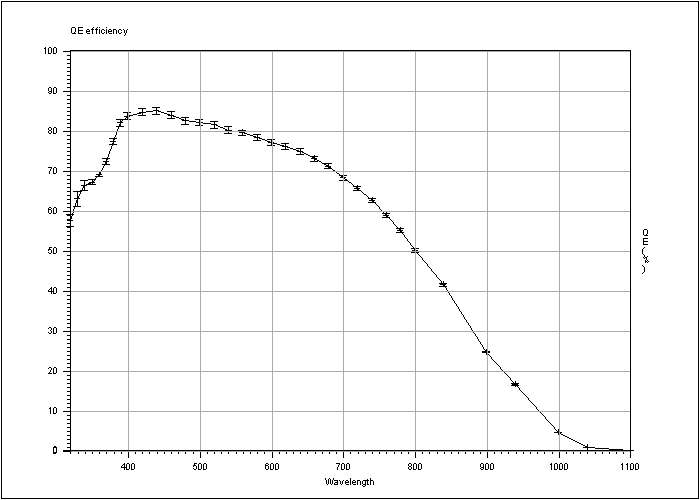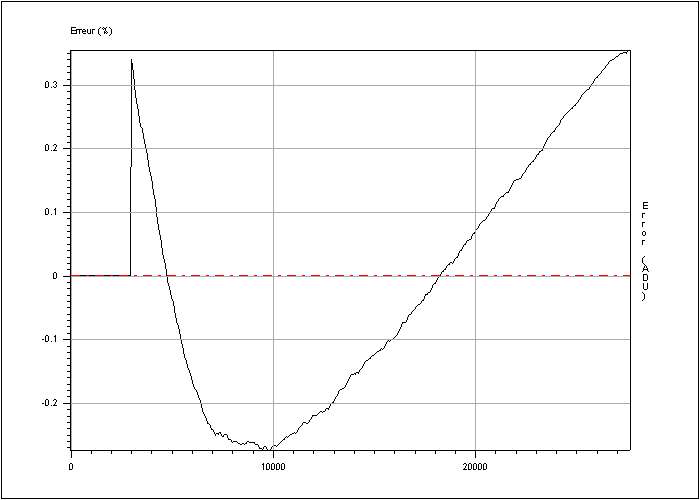
Apus: ESO CCD Test Report
EEV 44-82 -1-A57
CCD name : Apus
Serial number :
9252-14-02
Type : Backside, Single layer AR Pixel size 15x15 µm
Number of photosensitive pixels 2048 x 4102 [HxV]
Number of
outputs : 2
Overall rating :
Test date : 02/11/2000
Clock mode: EEV 1p/225k/HG 512 Conversion Factor= 0.53746e-/ADU ±0.001545 for 24744.9ADU RMS noise = 3.7507e- ±0.1753 CCD temperature : -120.0Cº Window area is : X1= 64 X2= 2093 Y1= 4 Y2= 507 Bandwidth 5nm Wav. QE% PRNU rms% Phase= 320 57.5 ±1.6 5.05 7.006147 330 62.9 ±1.8 4.93 6.979452 340 66.2 ±1.3 4.88 6.968215 350 67.1 ±0.66 4.89 6.970295 360 69.1 ±0.68 4.86 6.966696 370 72.3 ±0.71 4.42 6.869861 380 77.2 ±0.76 3.35 6.593095 390 81.9 ±0.84 2.56 6.321791 400 83.6 ±0.85 2.11 6.124742 420 84.6 ±0.85 1.61 5.846838 440 84.9 ±0.85 1.4 5.694374 460 83.8 ±0.84 1.32 5.633757 480 82.4 ±0.83 1.21 5.539744 500 82 ±0.82 1.17 5.509408 520 81.4 ±0.82 1.13 5.483239 540 80.1 ±0.81 1.1 5.458051 560 79.4 ±0.58 1.08 5.44497 580 78.2 ±0.78 1.1 5.462481 600 76.9 ±0.76 1.09 5.463989 620 76 ±0.75 1.11 5.483575 640 74.7 ±0.73 1.15 5.528542 660 72.9 ±0.71 1.22 5.583677 680 71.1 ±0.68 1.29 5.648755 700 68.2 ±0.64 1.35 5.681619 720 65.5 ±0.6 1.54 5.805105 740 62.5 ±0.57 1.7 5.869988 760 58.8 ±0.53 1.92 6.003469 780 54.9 ±0.48 1.91 5.971177 800 50 ±0.43 2.01 6.043367 840 41.4 ±0.35 2.04 6.063942 900 24.6 ±0.2 2.28 6.120477 940 16.5 ±0.13 3.94 6.724411 1000 4.55 ±0.034 7.07 7.286271 1040 0.715 ±0.0053 7.28 7.313993 1100 0.0772 ±0.00057 10.1 7.710604
Table 1: Measurement of the Quantum Efficiency.

Figure 1: Graphic representation of the QE.
Figure 2: Graphic representation of the PRNU.
In this section you can compare the QE we measured with the testbench and
QE Minimum specification
Typical QE
QE from Marconi
Figure 3: Comparison between the QE measured by ESO, the QE measured by Marconi,
ESO specification and minimum specification.
|
Comparison QE ESO / QE Marconi |
||||
|
Wavelength (nm) |
QE ESO (%) |
QE Marconi (%) |
Difference (Eso - Marc. %) |
Relative difference (Marconi as reference %) |
|
350 |
67.1 |
58.3 |
8.8 |
15.1 |
|
400 |
83.6 |
82.1 |
1.5 |
1.8 |
|
500 |
82 |
81.2 |
0.8 |
1 |
|
650 |
73.8 |
73.8 |
0 |
0 |
|
900 |
24.6 |
28.5 |
-3.9 |
-13.7 |
Table 2: Difference and relative difference between ESO measurement and Marconi.
Figure 4: Graphic representation of the difference and the relative difference.
For the flat field we use three wavelengths, 350nm, 600nm and 900nm. For each wavelength we make two images, high level (45000 ADU) and low level (1000 ADU).
350nm (UV), bandwidth 5nm |
600nm, bandwidth 5nm |
900nm, bandwidth 5nm |
|||
High level |
Low level |
High level |
Low level |
High level |
Low level |
Table 3: Flat field for three wavelengths.
The time exposure, for the long dark exposure, is 3600 seconds.
Table 4: Bias and dark.
Readout speed: 50kps Right readout port Conversion Factor= 0.432e-/ADU ±0.001 for 27266.4ADU RMS noise = 2.9e- ±0.2 Left readout port Readout speed: 50kps Conversion Factor= 0.556e-/ADU ±0.002 for 26601ADU RMS noise = 2.5e- ±0.2 Readout speed: 225kps Right readout port Conversion Factor= 0.418e-/ADU ±0.002 for 20909.6ADU RMS noise = 4.0e- ±0.3
RMS non linearity (%) = 0.201357 Peak to peak non linearity (%)= 0.629146

Figure 5: Error of linearity
Figure 6: Residual non linearity.
Exposure time (s) = 3600 Dark current : 0.55 ± 0 e-/hour/pixel Cosmic event rate : 1.16 ± 0.01179 events/min/cm²
Horizontal CTE = 0.999992 Vertical CTE = 0.9999997
In this section we expose the hot pixel, the dark pixel, the trap and the very large trap we found and how.
A hot pixel provides a signal of > 60 e- / pixel / hour. To find them we use a median dark image. We take the median of the image and to find the hot point we add the mean in (e- / pixel / hour) plus the limit (60 e- / pixel / hour). All the pixel which have a value upper than this limits are considered as hot pixel. I repeat this manipulation with two other median filter to confirm the results
Result: One hot points.
On our images this point is to the coordinates:
|
Position |
Image |
Histogram around the hot pixel |
X= 0441 Y= 0948 |
|
|
Table 5: Position and images of the hot pixels.
A dark pixel is one with 50% or less than the average output for uniform intensity light level, measured with a flat field level around 500 photo-electrons.
Result: No dark pixel detected.
A trap is defined as a pixel that captures more than 10 electrons, measured with a flat field level around 500 photo-electrons.
Result: Not available
A very large trap is defined as a pixel that captures more than 10 000 electrons, measured with a flat field level around 90% of full well capability.
Result:
On our images this point is to the coordinates:
|
Position |
Image |
Histogram around the very large trap |
|---|---|---|
X= 1571; Y= 2661 X= 1572; Y= 2661 X= 1573; Y= 2661 X= 1574; Y= 2661 |
|
|
Table6: Position and images of the very large trap.
A bad column is 10 or more contiguous hot or dark pixels in a single column or a very bright pixel or a very large trap.
Result: Four bad columns. The bad columns start to the point
X= 1571; Y= 2661
X= 1572; Y= 2661
X= 1573; Y= 2661
X= 1574; Y= 2661
Here is a summary of cosmetic defects:
|
Hot pixel |
Dark pixel |
Trap |
Very large trap |
Bad column |
|---|---|---|---|---|
|
1 |
\ |
\ |
4 |
4 |
Table 7: Summary of cosmetic defects.
Back to the overview page ESO Test Reports for the OmegaCAM CCDs